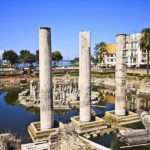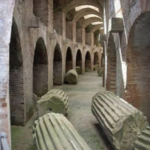![]()
Le origini della città di Pozzuoli si perdono nel tempo e nella leggenda. Un’antichissima tradizione la vuole fondata nel 529 a.C. da alcuni esuli in fuga dall’isola di Samo con il nome di Dicearchia (giusto governo). Il promontorio tufaceo del Rione Terra accolse successivamente i primi coloni romani giunti nel 194 a.C. che fondarono Puteoli, nome derivato dall’abbondanza delle sorgenti minerali raccolte in piccoli pozzi. Sotto le fondamenta degli edifici seicenteschi, è ancora è visibile parte della città sotterranea grazie ai ritrovamenti della primitiva cinta muraria greca, della struttura urbanistica romana e di parte del Tempio Augusteo inglobato nella Cattedrale.
L’Anfiteatro Flavio di Pozzuoli è il terzo per grandezza in Italia nonché uno dei meglio conservati in assoluto in particolare per ciò che attiene al suggestivo dispositivo dei sotterranei. L’Anfiteatro fu costruito in età augustea quando Pozzuoli divenne Colonia Flavia Augusta e come si evince dalle iscrizioni ritrovate presso i quattro ingressi, le spese furono sostenute dell’erario della città per suggellare il momento di grande prosperità. Orientato con l’asse maggiore e minore secondo i quattro punti cardinali, poteva contenere fino a 40 mila spettatori.
Il Serapeo, conosciuto anche come Tempio di Serapide, era in realtà un elegantissimo mercato coperto costruito secondo il tipico impianto orientale ovvero con un ingresso, le botteghe, il porticato, una rotonda, un abside con tre nicchie e sul fondo le latrine pubbliche. Appartengono al pronao del sacello le tre colonne ancora visibili al centro della struttura, diventate nel tempo i più evidenti misuratori del “bradisismo” ovvero il tipico fenomeno vulcanico flegreo. L’errata attribuzione fu causata dal ritrovamento di una statua del dio Serapide. Il mercato testimonia l’importanza dell’antico commercio puteolano che raggiunse l’apice nel periodo imperiale. Statue e iscrizioni oggi esposte al Museo Archeologico dei Campi Flegrei, ricordano l’atmosfera cosmopolita dell’emporio puteolano frequentato da molti Orientali che importarono anche i loro culti esotici.
- Il tour è disponibile sia per individuali che per gruppi ed è adatto a tutte le età.
- La durata prevista è di 3 ore.
- La tariffa varia in base al numero di partecipanti
![]()
![]() It’s thought that a band of exiles from the island of Samo founded in 6th b.C. the city of Dicearchia (good government). In 194 BC. the new roman colony of Puteoli was settled on the headland of Rione Terra as a fortress raised on a cliff. The roman name (Puteoli) was Latin for “little wells” because of the many sulfur fumarole in the area. It was a world port receiving fleets from around the Mediterranean and also a channel for Campanian exports. Part of the underground city is still visible thanks to the finding of the Greek city walls, the Roman urban structure and part of the Augusteus Temple incorporated in the Cathedral.
It’s thought that a band of exiles from the island of Samo founded in 6th b.C. the city of Dicearchia (good government). In 194 BC. the new roman colony of Puteoli was settled on the headland of Rione Terra as a fortress raised on a cliff. The roman name (Puteoli) was Latin for “little wells” because of the many sulfur fumarole in the area. It was a world port receiving fleets from around the Mediterranean and also a channel for Campanian exports. Part of the underground city is still visible thanks to the finding of the Greek city walls, the Roman urban structure and part of the Augusteus Temple incorporated in the Cathedral.
Puteoli’s importance is evident from the ruins of the third largest Amphitheater in Italy built during the reign of Vespasian (69-79) and paid by the population of Pozzuoli in honor of the Emperor. The underground of the arena are still well-preserved and no other amphitheater of antiquity gives us as clear a picture of how the arena was set up and used in the Roman games.
Near the harbor there is so- called the “Temple of Serapis” that was really a market place. On dry land, the bases of the columns were underwater until the 1980s, when significant seismic activity shifted the ground level.
- Tour available for both individuals and groups
- Suitable for all ages.
- The expected duration is 3 hours.
- Rate varies according to the number of participants






